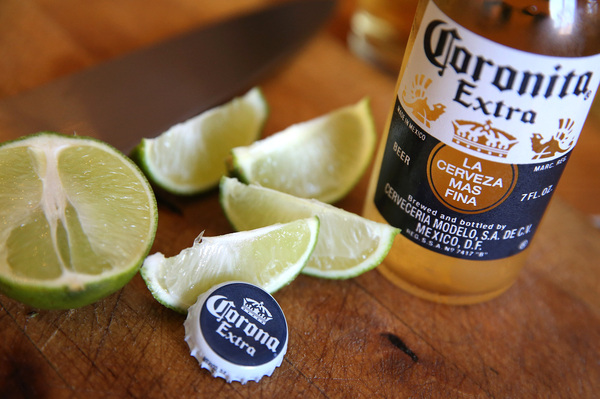How NAFTA changed American, Mexican food forever
Go Deeper.
Create an account or log in to save stories.
Like this?
Thanks for liking this story! We have added it to a list of your favorite stories.

If you were to try and list the biggest game-changers for the American food system in the last two decades, you might note the Food Network, or the writing of Michael Pollan, or maybe even the evolution of Walmart.
But you'd probably overlook NAFTA, the North American Free Trade Agreement.
And that would be a mistake, according to a lengthy report out early February from the U.S. Department of Agriculture.
In one fell swoop, the report finds, President Bill Clinton's 1994 landmark legislation unleashed a dizzying array of market forces on agriculture, with vast long-term impacts. And with greater access to the neighboring markets, farmers and other food producers in the U.S., Mexico and Canada have helped reshape diets in some pretty significant ways.
Turn Up Your Support
MPR News helps you turn down the noise and build shared understanding. Turn up your support for this public resource and keep trusted journalism accessible to all.
If you take the report at face value, NAFTA has greatly increased the "economic integration" between the U.S., Mexico and Canada. Instead of giving preferential treatment to domestic products by imposing tariffs on imports, the three NAFTA countries let goods flow relatively freely between them. And that includes food — a lot of it.
Today, Americans consume twice as much fruit, and three times as many vegetables, from both Mexico and Canada as we did two decades ago, according to the report. A parade of greenhouse tomatoes, peppers and cucumbers now come down, often by truck, from Canada. From Mexico, we've seen huge increases in imports of seasonal fruit.
Mexican berries are an obvious example, but 20 percent of the imported watermelon we consumed in 2010-2012 also came from Mexico, compared with 5 percent in 1991-1993. As for imported avocados, 49 percent now come from Mexico, up from 0 in 1991-1993. Lots more tomatoes and papaya are coming from south of the border, too.
This produce trade boom, says the report, is only partly a product of tariff changes. It's also a result of the improved food safety standards now in place in Mexican fields, which allow more produce to get past U.S. inspectors.
But while NAFTA has largely meant that we're getting more of our favorite fresh foods from our next-door neighbors, the USDA suggests that NAFTA is profoundly transforming the food system in Mexico, sometimes in less healthful ways.
While Mexico is now the largest market for American apples and pears, U.S. meat exports to Mexico have doubled in the last two decades. Our exports of feed corn for livestock also now account for nearly one-third of the country's supply — meaning that even when Mexicans eat domestic meat, it's often been fed on American corn.
But the biggest change is how much more processed food and American-style supermarkets our neighbors have been importing. Indeed, American investment in Mexican food manufacturing — rather than agriculture, for example — has tripled since 1999, as have sales of American processed food products there.
American companies are also sending Mexico the ingredients to make foods like high-fructose corn syrup; HFCS exports to Mexico are now 863 times what they were before NAFTA. And all of that ends upon the shelves of supermarkets, whose business model relies heavily on processed food. Walmart, which opened its first Mexican store in 1991, four years after it began selling groceries, now operates 2,114 stores that offer food in Mexico. You've likely heard that America's in the middle of a craft beer revolution. Well, we're also, apparently, swooning for cerveza de Mexico. In 2013, we imported about 2 million tons of Coronas and Modelos, making beer Mexico's largest agricultural export to the U.S.
While we may be glad that Corona is now plentiful across the U.S. (and that we're washing down more guacamole made with Mexican limes and avocados with it), there is a dark side to how NAFTA has reshaped the region's food systems: working conditions. And you won't find much exploration of that in the USDA report.
While the USDA report discusses immigration and guest worker programs, it does not address the disconnect between improved attention to produce without a corresponding attention to workers' welfare. As a recent Los Angeles Times investigation of Mexican farms growing tomatoes bound for the U.S. market found, "The contrast between the treatment of produce and of people is stark." Mexico has also likely paid a price for opening its gates to so much processed food laden with high-fructose syrup and other not-so healthful ingredients. As the Institute for Agriculture and Trade Policy, a Minnesota-based think tank, has shown, Mexico's recent spike in obesity and soda consumption correlates with the passage of NAFTA. Tracie McMillan is the author of The American Way of Eating, a New York Times bestseller, and a senior fellow at the Schuster Institute for Investigative Journalism at Brandeis University. You can follow her on Twitter @tmmcmillan. Copyright 2019 NPR. To see more, visit https://www.npr.org.


